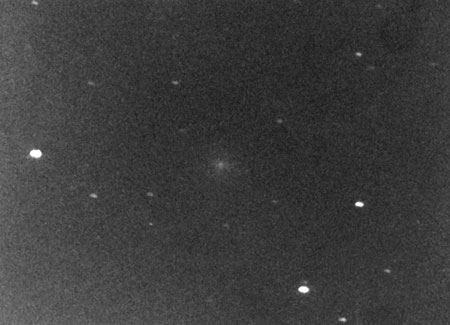15P/Finlay is a memorable comet to us Japanese. Back in October
1919, Mr.Tetsuo Sasaki, who was an assistant at Kyoto University's Kwasan
Observatory, found by chance a 9th-magnitude comet in Capricornus while
observing at the observatory's yard. It turned out to be a return of Comet
Finlay. Subsequently, the comet was named Comet Finlay-Sasaki. In those
days, there was a rule that allowed both discoverer's and recoverer's names
to be used, though the recoverer's name was added only during the comet's
particular apparition.
Mr. Sasaki died young, but this comet returned many times
after his death. Each time it returned, Mr. Sasaki's achievement was talked
about and passed on to next generations of observers.
Since I began my comet search in 1950, I had also conducted
photographic observations. In those days, it was extraordinary for amateur
astronomers to attempt a systematic search to recover periodic comets.
Not long after my observatory was moved to Geisei village under dark skies
from my residence in Kochi, Comet Finlay returned.
This is July 2008 and I am writing this story, while Comet
Finlay is glowing in the predawn sky. I have been observing this comet
with Geisei's 70cm reflector since the end of June. It was in the second
half of June, 1974, when I recovered this comet at Geisei. The conditions
were the same as this year. At an extremely low altitude in the morning
twilight immediately before the daybreak, the 15th-magnitude comet was
casting its faint light on the 21cm mirror. The discovery was immediately
reported by a telegram to Tokyo Astronomical Observatory, which was in
turn sent to observatories across the country as well as to the Smithsonian
half way around the world. In those days there was no FAX nor Internet.
I found a photograph taken at that time without any data
accompanying it. The time of the discovery was 3:40 am on June 25, 1974,
Japan Standard Time. I have a number of photographs taken that day and
the following day. This photograph must be one of those taken on the day
of the discovery with Kodak's 103a-o glass plate using a 21cm f/5 telescope
(Kojima mirror). The skies those days were excellent and 103a-o plates
were very effective. It had been developed exclusively for astronomical
use with very little reciprocity failure. A series of recovery of periodic
comets at Geisei owes much to Kodak's photographic plates. They could easily
compete with today's CCDs.
Copyright © 2010 Tsutomu Seki.

